

HATCHET The GW

Faculty Senate Executive Committee chair steps down after members request resignation
GIANNA JAKUBOWSKI
ASSISTANT NEWS EDITOR
Faculty Senate Executive Committee Chair Katrin Schultheiss stepped down from her role after committee members requested she resign over unspecified concerns, prompting heated commentary at the body’s Friday meeting over the nature of the committee’s request.
Schultheiss stepped down from her role helming FSEC — a committee elected by the Faculty Senate and tasked with guiding the body’s work — sometime before Friday’s meeting at the request of six of nine FSEC representatives,
in lieu of the committee’s alleged threat to hold a vote of no confidence. The three FSEC members who opposed calls for Schultheiss’ resignation criticized the other members’ request, prompting Faculty Senator Jamie Cohen-Cole to draft a resolution to remove all FSEC members from their positions, though the motion never reached a vote after the meeting lost quorum. Based on comments made at the meeting, six FSEC representatives — Arthur Wilson, Jonathan Eakle, Scott Kieff, Amita Vyas, Sameh Badie and Rhonda Schwindt — called on Schultheiss
to step down, while John Warren, Jennifer Brinkerhoff and Jeff rey Akman opposed the way the six members handled the situation. The members cited a build up of unspecified concerns over several months as their reason for their request.
The three representatives that backed Schultheiss — Warren, Brinkerhoff and Akman — declined to comment further on the matter, and none of the six who requested Schultheiss step down returned a request to comment. Schultheiss was not present at the meeting Friday and did not return a request for comment.
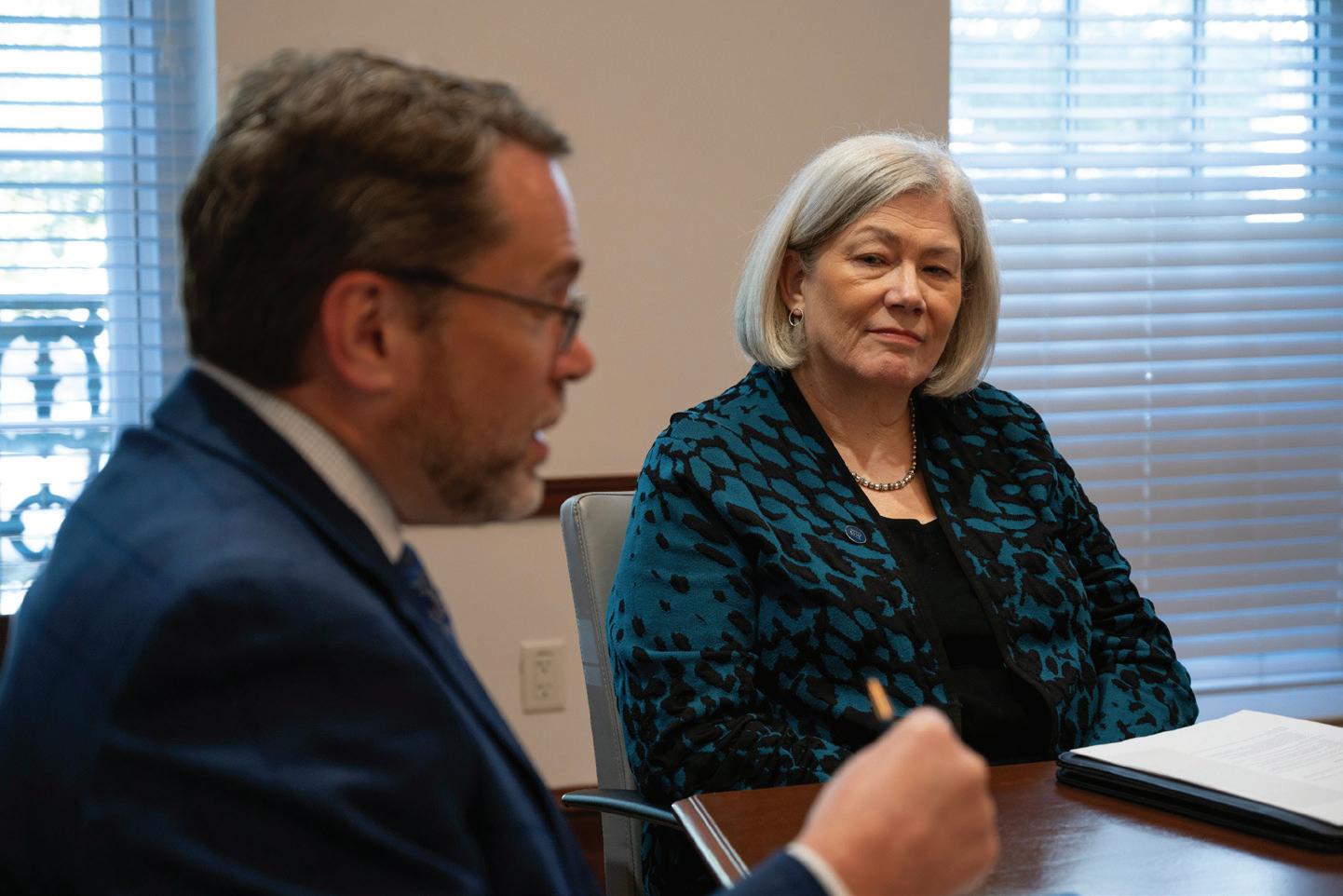
Granberg wins community support for strategic framework
research enterprise over the next five to seven years, starting with three priorities.
GW is gaining community support for the strategic framework officials launched Tuesday, marking a divergence in public perception of the University’s priorities and engagement strategies after the former president’s plan faced criticism for sidelining stakeholder voices.
Student, faculty and staff leaders said the strategic framework reflects their input over the last year and a half and marks a shift from the community backlash former University President Thomas LeBlanc faced for his 2019 plan, which included a goal of cutting undergraduate enrollment by 20 percent and increasing STEM majors by 30 percent.
University President Ellen Granberg and Interim Provost John Lach unveiled the University’s first guiding framework since 2020 last week — a blueprint outlining plans to boost student success and expand GW’s
The framework outlines the three priorities on its website — generating scholarship with impact, preparing students to be strong and resilient leaders and strengthening the University’s foundation for excellence — along with 12 goals GW plans to accomplish in the next five to seven years, which officials will implement in a phased approach to ensure “clear progress” and adaptability over time. The website states that adopting a framework — rather than a plan, as GW did under LeBlanc — establishes broad priorities instead of specific actions, allowing flexibility in implementation amid ongoing changes in higher education.
Chief of Staff Scott Mory said the Steering Committee — a group of 15 officials Granberg charged on Oct. 2 with overseeing the implementation of the framework
and designing a process to source and evaluate phase two initiatives — will continue to work with the Faculty Senate, Staff Council and Student Government Association as the framework is implemented over the next five to seven years, and each working group will solicit community feedback.
Officials announced last month the creation of three working groups to implement the initial framework initiatives, including enhancing GW’s interdisciplinary research ecosystem, better leveraging D.C. experiences as part of student learning and improving academic and career advising.
Community members said their voices are reflected throughout the strategic framework and expressed anticipation for officials to advance its three initial projects and expand future initiatives, following concerns last year from some members that officials did not reflect their input in the draft framework.
GW has paused its search for a vice provost to lead the Office of Diversity, Equity and Community Engagement as officials review programs in light of Trump-era policies, leadership changes and the University’s new strategic framework, a spokesperson confirmed.
A University spokesperson said officials put the search on hold after launching it following the former vice provost’s departure 15 months ago, citing internal and external factors that prompted a reevaluation of programs, including updated federal guidance on diversity, equity and inclusion initiatives and the strategic framework GW released Tuesday. ODECE’s former vice provost, Caroline Laguerre-Brown, left GW in July 2024 after eight years, and officials have largely stayed quiet on the status of filling the position, last describing the search as “ongoing” in November 2024.
“GW maintains a strong commitment to fostering within the bounds of the law a supportive, welcoming and inclusive environment for all members of our community, as such an environment is central to our ability to pursue our mission with excellence,” the spokesperson said in an email.
President Donald Trump over the last few months has intensified his attacks on



GW halts search for top diversity post amid Trump DEI crackdown
DEI initiatives nationwide, starting with a January executive order directing the elimination of DEI positions in the federal government “to the maximum extent allowed by law” and warning that universities failing to comply could lose federal funding. More than 400 campuses in 47 states and the District have made changes to DEI offices, jobs, training and related activities since January 2023, with an uptick heading into the 2025-2026 academic year in light of shifting federal policies.
Out of GW’s 12 peer schools, eight have shuttered their DEI offices — including the University of Miami, Syracuse University and Northeastern University — since the start of Trump’s second term. GW Law quietly dismantled their DEI website sometime between December 2024 and early March, but the remainder of GW’s diversity sites appear to be intact.
In University President Ellen Granberg’s letter to the community earlier this month reflecting on the “convergence of challenges” GW is facing, she said officials are looking at a path forward for diversity and inclusion efforts on campus that is “fully inclusive” and “welcoming to all.” She said officials are working with the general counsel’s office and outside legal experts to “validate” that GW’s diversity initiatives meet federal law standards.
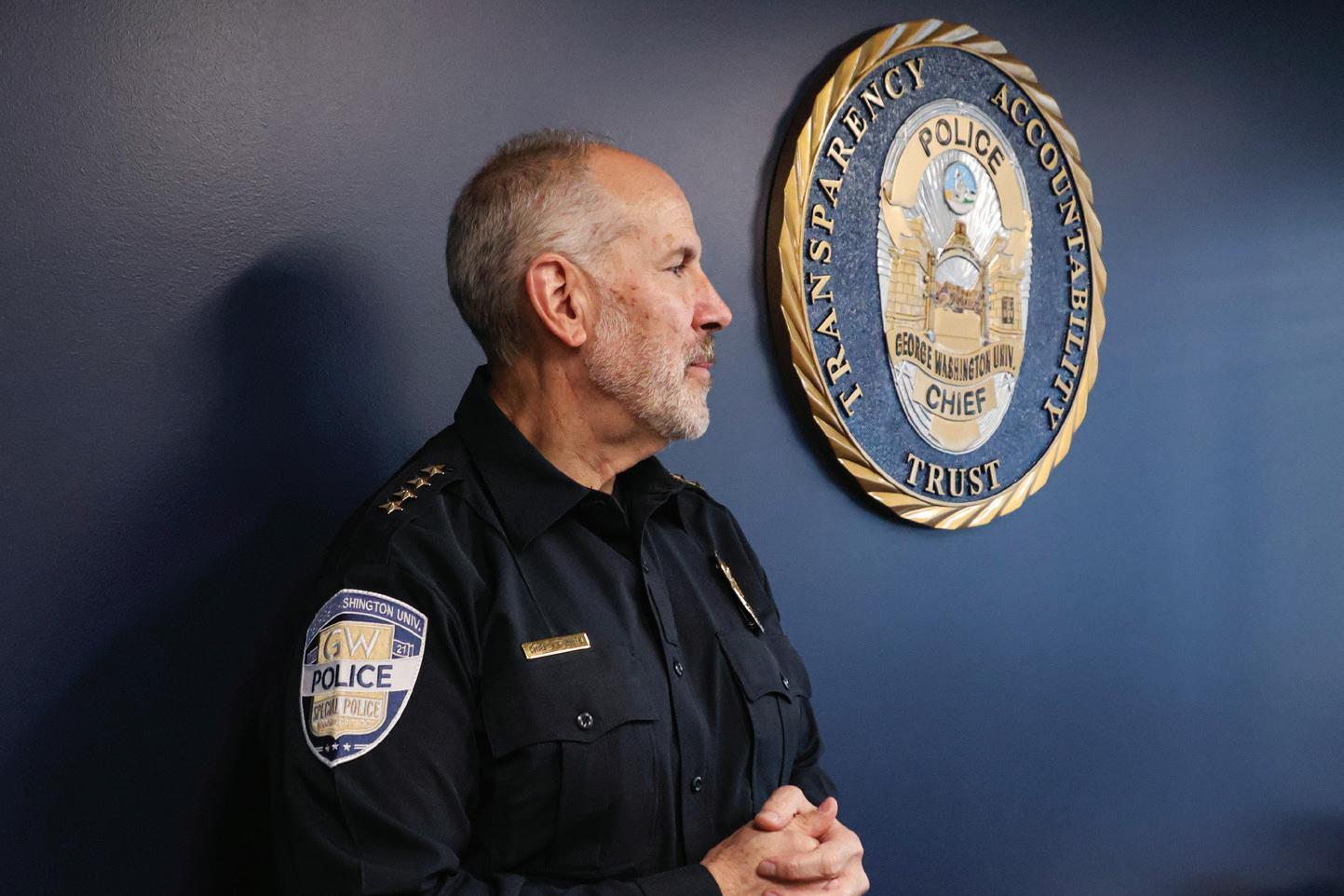
chief vows to rebuild trust a year after department turmoil
hiring quality officers and bolstering officer training.
More than a year after gun safety failures fractured the GW Police Department, triggering mass officer departures and the former chief’s resignation, new GWPD Chief Victor Brito is working to rebuild the department and restore trust with the community.
Brito, who began his tenure as chief of campus police on Aug. 4, is inheriting a department that has faced years of high turnover, low officer morale and reports of insufficient training and safety violations — challenges he said he’ll study as he charts the department’s future. In a sit-down interview with The Hatchet, Brito outlined his plans to rebuild trust with the community following the department’s controversial arming rollout, focusing on building relationships with key campus stakeholders,
“My clear focus is on the future,” Brito said. “I have to understand what happened in the past, but I can’t dwell on it. I have to dwell on things that are going to propel us to be successful in the future.”
“I’ve done virtually everything I can in law enforcement, but my greatest feat, and my greatest thing that I’ve ever had is my ability to connect with people and create relationships in communities, ” Brito said. In March, officials released findings from a third-party review of GWPD, which confirmed a September 2024 Hatchet investigation detailing previously undisclosed safety violations. But Brito and Associate Vice President of Campus Safety Katie McDonald, who was also present during the interview, said their leadership of campus safety operations will mark a departure from the communication approaches of past leaders.
“The chief, the leader of an organization, sets the tone, and this is a very different one than it has been in the past,” McDonald said.
Brito has served as a police officer for 37 years, including as chief of police in Rockville, Maryland and Hagerstown, Maryland, and in several leadership roles within the Metropolitan Police Department. In each role, he said he forged close ties with the communities he served, some of whom previously distrusted police officers at large, including by making intentional efforts to visit African American communities in Rockville. He said his extensive policing experience — coupled with his stint as an adjunct professor of justice, law and criminology at American University, which he said made the intersection of law enforcement and academics natural to him — makes him the right person to repair the department’s reputation at GW.
MATHYLDA DULIAN | ASSISTANT PHOTO
President Ellen Granberg and Interim Provost John Lach at a sit-down interview last week.
NICHOLAS WARE | STAFF PHOTOGRAPHER
Faculty Senator Anne Markus and Executive Committee representatives Jonathan Eakle and Arthur Wilson at Friday’s meeting.
LIQUOR LAW VIOLATION
West Hall
10/22/2025 – 3:30 a.m.
Closed Case
The GW Police Department and GW Emergency Medical Response Group responded to a report of an intoxicated male GW student. After concluding the student did not need medical attention, officials referred the case to Conflict Education & Student Accountability. Case closed. Referred to CESA.
DISORDERLY CONDUCT
District House Dining Area
10/21/2025 – 7:11 p.m.
Closed Case
GWPD responded to a report of a disorderly, non-GW affiliated individual. Officers made contact with the person, issued a bar notice and escorted them off the property. Case closed. Subject barred.
BURGLARY II/FORCIBLE DESTRUCTION OF PROPERTY/VANDALISM
Science and Engineering Hall
10/4/2025
Open Case GW staff reported an unknown male, non-GW-affiliated person damaged a door lock to gain access to the eighthfloor greenhouse. Case open.
SIMPLE ASSAULT (DOMESTIC VIOLENCE)
District House
10/19/2025 – 12 p.m.
Closed Case
A GW student reported being the victim of an assault by their boyfriend. GWPD referred the case to MPD. Case closed. Referred to MPD.
—Compiled by Bryson Kloesel
Israel-Hamas ceasefire brings cautious hope to campus as tensions linger
RYAN SAENZ ASSISTANT NEWS EDITOR
Community members are cautiously celebrating the ceasefire Israel and Hamas reached earlier this month, hopeful the agreement will bring peace to the Middle East and ease campus tensions but mindful of the deal’s fragility.
President Donald Trump brokered and announced the ceasefire on Oct. 8, which took effect two days later and required Hamas to release all remaining Israeli hostages and allow aid into Gaza in a major step toward ending the two-year war that has devastated the Middle East and dominated campus discourse. Students, including members of GW for Israel and Students for Justice in Palestine, said they expect campus tensions to remain high for the foreseeable future but hope both sides will become more open to dialogue if the ceasefire holds, while professors who teach on the Middle East warned the deal is fragile and only the first step in a long road to peace.
The onset of the war in Gaza sparked two years of protests across campus, with students demanding officials divest from companies tied to Israel, renewing conversations about antisemitism and anti-Palestinian discrimination on campus and staging a two-week pro-Palestinian encampment in University Yard in April 2024.
Hamas militants attacked Israel on Oct. 7, 2023, killing more than 1,200 Israelis and taking 251 hostages, triggering an Israeli military offensive in Gaza. Israel’s sweeping force since the onset of the war has devastated Gaza, with the Israeli military killing more than 67,000 Palestinians and injuring close to 170,000, according to Gaza’s Health Ministry. Roughly 2,000 Israelis have been killed or injured by Hamas since the war began, according to Israeli officials. The two-week ceasefire has already begun to teeter in its stability.

U.S. representatives like Vice Presi-
dent JD Vance and Secretary of State Marco Rubio visited Israel to aid negotiations, but both Hamas and Israel have reported instances of violence against each other. On Oct. 19, Israeli officials said Palestinian militants killed two Israel Defense Force soldiers, prompting Israel to respond with strikes and temporarily blocking aid from flowing into the territory. Israel halted strikes, returning to the ceasefire and movement of aid, the next day.
As a part of the ceasefire deal, Israel has also released nearly 2,000 imprisoned Palestinians.
Nate Neustadt, the co-director of education for GW for Israel, said now that the last 20 living hostages held captive by Hamas have been released, he hopes Israelis and Palestinians can work together to benefit both sides.
“Now that all of the living hostages are finally home, we look forward to a future where we can work with the Palestinians to create a long and prosperous future for both our peoples,” Neustadt said in a text message.
Government interns report financial strain, disrupted career experiences as shutdown persists
ANYA
Students interning and working for the federal government said the government shutdown has hurt their day-to-day finances and prevented them from having a “true” job experience in the federal government. Since the federal government shutdown began on Oct. 1, student interns and employees working for members of Congress and at Smithsonian museums have been out of work — a disruption they say has strained their finances and cut short valuable professional experience in government and museum affairs. The shutdown, triggered by Congress’s failure to pass funding legislation through Nov. 21, has led to mass furloughs, suspend-
ed pay for federal workers and the closure of federal buildings across D.C.
Ana Claire Hanley, a junior majoring in political science who interns for Speaker Mike Johnson (R-LA), said she has been furloughed since the government shutdown on Oct. 1, prompting her to take on a “side gig” at a consulting firm to earn extra income.
“I’ve consecutively worked on Capitol Hill since the start of summer without stop, so it was a very drastic change from commuting here three days a week minimum to just being at home and not really having much to do,” Hanley said.
Hannah Davis — a junior majoring in history and Asian studies, who works a few hours each week at the Smithsonian’s Air and Space Museum in D.C. — said the shutdown has threatened her financial stability as a college
student. She said that, in lieu of her usual online trainings, she is helping with a research project as part of an arrangement with her supervisors, but she won’t receive payment for this work until the government passes a spending bill and the Smithsonian reopens.
“We know we’re not going to come back this week,” Davis said. “So they have been very much like, ‘There’s no light at the end of the tunnel.’”
Davis said people need to remember the government shutdown isn’t just affecting civil servants but also a myriad of other workers in D.C. and the rest of the nation, like security guards at airports, National Park Service workers and interns.
“There’s a lot of people who are involved in federal work that are being affected by this,” Davis said. “So people who are volun-
teers at the zoos are getting affected by this. Security guards are getting affected by this. There are many.”
The government last shut down in 2019 for 35 days, the longest so far in American history, from late December 2018 into the new year.
Ari Ellerbroek, a sophomore majoring in international affairs and economics who interns with Sen. Chuck Grassley (R-IA), said she is continuing to work as usual despite not receiving a paycheck. She received one payment at the start of October but has not been paid since, though she expects to receive back pay for the hours she’s worked during the shutdown.
“The only thing that really has changed is I can’t give tours as much, and things are a little bit slower,” Ellerbroek said. “But I feel like I still got a good chunk of the experience.”

After releasing all living hostages on Oct. 13, Hamas released the remains of 15 hostages over the following few days but said they needed special equipment to locate and return the remains of the 13 other hostages.
A representative of SJP — which disaffiliated from GW after facing multiple suspensions — who requested anonymity over fears of University retaliation, said the scenes of displaced Palestinians beginning to return to their homes in Gaza is a symbol of Palestinians’ commitment to rebuilding what the war has destroyed over the past two years.
The representative said they hope the ceasefire will offer Palestinians a “brief moment of rest” but condemned Israel’s recent actions — including continued airstrikes, the detention of Palestinian prisoners and the temporary halt of aid into Gaza during the airstrikes that followed the ceasefire agreement.
“Palestinians’ psychological scars will not heal overnight, if at all,” the SJP representative said.
GW undergoes revision of mission statement
SACHINI ADIKARI SENIOR STAFF WRITER
Officials are revising GW’s mission statement nearly six years after they last revamped it — an initiative that comes as GW is undergoing a flurry of initiatives aimed at shaping the strategic future of the University.
Members of the University community and experts said the statement revision — which officials expect to present to the Board of Trustees in spring 2026 and is being led by a working group — is timely and necessary to make the dated mission more reflective of the University’s current identity and values, like its location in D.C., while also being used to appeal to donors. The revision comes in tandem with the University’s large-scale administrative initiatives as officials work on implementing their new strategic framework, brand refresh and undergo the process of reaccreditation.
Universities use mission statements, which typically incorporate community feedback and are approved by the Board, to describe the institution’s goals and purpose and outline its leadership’s duty of obedience to carry out that mission. GW’s current statement, which officials last revised in 2019, is taken word-for-word from GW’s congressional charter and highlights the University’s commitment to education and research.
Chief of Staff Scott Mory said University President Ellen Granberg charged a 20-member steering committee led by him and Deputy Provost for Academic Affairs Terry Murphy to engage members of the University community this semester through a series of workshops to gauge ideas and potential themes for the new statement. He said the committee will consult the Board and other University leadership, the Faculty Senate, the Student Government Association and the Staff Council, before consulting the community as a whole.
“After sharing potential statements with the president, provost and Board of Trustees, the drafts will be shared with the GW community early next semester along with an opportunity for all our community members to add their voices and ideas to help shape the final version,” Mory said in an email. Murphy said officials want the new mission statement to be distinctive and capture GW’s “rich history” while still being relevant today, adding that they intend to make the statement reflective of its future goals, while “positioning” GW with its peer schools and in higher education itself.
“The timing of this effort truly could not be better,” Murphy said in an email. “The launch of GW’s new Strategic Framework, the current brand refresh and the Middle States reaccreditation process all provide the university with a clear expression of its strengths and aspirations, creating the perfect moment to revise our mission statement.” GW last underwent an overhaul of its mission statement in February 2019, under the Board’s three-year review of its bylaws following the University’s 2018 reaccreditation under Middle States Commission on Higher Education. Middle States is currently undergoing its reaccreditation process for GW — conducted every eight years — which includes a two-year-long self-study launched in fall 2024 and requires the University to evaluate its mission, quality, student success and resources.
Eric Lawrence, the chair of the political science department, said officials held a listening and discussion session about the mission statement on Oct. 9 with the GW Leaders Forum — a group composed of over 300 department heads and administrative leaders — where officials asked members to share their ideas after looking at GW’s current mission statement and those at other universities.
Officials evacuated more than 900 students from Thurston Hall while police swept the building for a bomb, after GW received a threat from an anonymous caller.
KYRA WOOD | ASSISTANT PHOTO EDITOR
Pro-Israel and pro-Palestinian protesters at recent student demonstrations.
MFA CEO declines interview requests amid restructuring, mounting losses
As University officials continue negotiations after announcing an agreement to distance GW from the Medical Faculty Associates’ persistent losses, the practice’s chief executive has delayed and then declined two formal interview requests over the last year.
The Hatchet first requested a sit-down interview with MFA Chief Executive Officer Bill Elliott in November 2024 after he took on the role permanently in October 2024, seeking to ask about how he planned to tackle practice’s mounting debt — which reached $444 million at the end of fiscal year 2025 — to which University spokesperson Kathy Fackelmann responded that Elliott had a “packed” schedule and was not available for an interview, also recommending the paper ask again in the late summer or early fall 2025. When The Hatchet requested an interview this month after officials an-
nounced GW had come to an initial co-funding agreement with Universal Health Services in response to the losses, MFA Chief Communications and Marketing Officer Anne Banner said Elliott is “not available” for a sit-down interview at this time and did not provide a timeline for a potential future interview.
Banner did not return a request for comment on why Elliott is not available for an interview.
The Hatchet also sent more than a dozen emailed questions to Elliott and GW Chief Financial Officer Bruno Fernandes this semester, seeking clarification on officials’ initial mention of negotiations with UHS. Elliott and other administrators declined to comment in September on how long the talks had been underway, who initiated them or how past legal disputes between the MFA and UHS influenced the decision to restructure the practice.
Upon reports that the MFA lost $100 million during FY2025,
The Hatchet also directed questions to Elliott and Fernandes earlier this month on why the MFA has not seen a meaningful reduction in debt despite promises that his leadership would address the crisis, which they declined to respond to. They also declined to comment on why MFA losses increased in the second half of FY2025, what steps officials are taking to resolve the practice’s “operational” and “nonoperational” issues and whether the $100 million loss in FY2025 influenced the decision to enter negotiations with UHS.
Officials, including University President Ellen Granberg, over the past year have repeatedly pointed to Elliott’s hiring as a step in the right direction to solving the MFA’s debt crisis, although the practice’s losses have continued to mount since his installment.
Elliott last spoke publicly to the GW community at a March Faculty Senate meeting, where he provided an update on the MFA’s performance.

Six months after GWPD report, community credits progress
RYAN J. KARLIN SENIOR STAFF WRITER SAMANTHA BUCHARD REPORTER
Community members praised the GW Police Department’s heightened communication and efforts to begin implementing recommendations from a third-party investigation about six months after its release but want more clarity on how officials are enacting the reforms.
An investigation by the law firm Willkie Farr & Gallagher, released in March, found officials failed to adequately consult the community before arming GWPD officers and confirmed allegations of gun safety violations during the arming rollout. GWPD Chief Victor Brito, who started in August, said the department is addressing the report’s recommendations by reforming training practices, consolidating safety operations and rebuilding trust with the GW community but more than six months later, some faculty and students feel the University should provide more consistent updates about its progress in addressing the report’s recommendations.
The third-party investigation confirmed allegations by former officers of safety violations during the arming of about 20 GWPD officers. It recommended abandoning the planned hybrid model in favor of arming all officers, hiring a dedicated training officer, creating mental health and rapid response units and strengthening ties with outside law enforcement.
Associate Vice President of Campus Safety Katie McDonald said in an interview that the University adopted some of the report’s recommendations — like combining safety functions under the leadership of Brito — but decided against some, like arming all of the force’s officers. McDonald confirmed that the department has armed eight officers to date, and officials are not considering arming more.
McDonald said the University intends to hire a dedicated training officer and unify training across safety organizations but did not specify a timeline for hiring. Officials also made changes in 2023 for GWPD officers to refer mental health-related dispatches to GW Emergency Medical Response Group instead of intervening directly, which
can be “overwhelming” for the subject, which McDonald said addressed the report’s mental health recommendations.
“University spokesperson Julia Garbitt said in an email last month that GW has implemented several changes to campus safety and security in recent years, including the establishment of the assistant vice president of university resilience role and the Campus Safety Advisory Committee, a group that shared safety input with officials on campus safety matters.
Community members say now they largely appreciate the progress made since the third-party report’s March release, like improved communication. But they said they want officials to clearly communicate the change they’re making in response to the report, including through consistent Universitywide updates from officials about the status of arming officers.
Scott White — an associate professor and director of cybersecurity programs and member of the Faculty Senate — said he believes the officials have increased transparency by providing updates during Faculty Senate meetings and the Senate Standing Committee on Physical Facilities and Campus Safety as well as facilitating student and faculty involvement in campus safety planning.
“I think we should be satisfied with the efforts of the University,” White said.
Dwayne Kwaysee Wright, a member of the Campus Safety Advisory Committee and professor of higher education administration, said the University had made progress rebuilding trust through initiatives like adding the new assistant vice president of university resilience role and hiring McDonald.
“That could be just because it was such a low bar, but they’re doing a lot better than they were,” Wright said.
Philip Wirtz, a professor of decision sciences, said he is “not aware” whether the University has followed through on many of the report’s recommendations. He said GWPD has not appeared to be more visible on campus since the report was released and that he hasn’t noticed officers establishing robust relationships with other law enforcement agencies.
“I am more aware of the National Guard on campus than of a more visible GWPD presence,” Wirtz said in an email.
Granberg discusses strategic vision, boosting student success at alumni event
EDWARDS
ELIJAH
University President Ellen Granberg outlined her plans to use the University’s strategic framework as a tool to strengthen student success, expand research and build community pride during a leadership dialogue at Jack Morton Auditorium on Saturday.
Granberg reflected on her first two years as the University’s first female president and on the strategic framework officials launched Tuesday, which she said will help improve student outcomes through stronger career and academic advising, increase access to opportunities in D.C. and grow the University’s research capabilities. Granberg spoke with alum Carrie Potter, a School of Business bachelor’s and master’s graduate and former Student Government Association president, during the Alumni & Families Weekend conversation before a packed auditorium.
Granberg said the University’s strategic framework grew from
months of listening sessions with students, faculty and alumni, and input consistently pointed to the same three areas of focus outlined in the framework: generating scholarship with impact, preparing students to be strong leaders and strengthening the University’s foundation for excellence. Granberg also pointed to the two overarching principles guiding the framework — growing research and strengthening student success — as ideas that stemmed from community input.
“When you allow and you encourage that much input, you can end up with kind of a soup,” Granberg said. “It was amazing how quickly and fully the input aligned along those three and so then we knew we had it because it came from all these different sources.”
Officials in April released a draft framework for feedback from the community before the Board of Trustees adopted the final strategic framework during its June retreat. The framework marks GW’s first strategic blueprint for the Univer-
sity’s direction since 2020 and outlines three priorities GW plans to accomplish in the next five to seven years.
Granberg described the framework as “relatively simplistic” in defining the University’s guiding principles, emphasizing her inten
tion for clear and flexible priorities that GW can pursue in the coming years. She said as officials decide which University areas and programs to invest time and funding in, they will consider whether the initiative supports student success and their ability to “thrive” after graduation and whether it enhances research.
“If the answer to those two isn’t yes, then we really have to ask ourselves, is this something that we should be investing in?” Granberg said. “And that kind of muscle memory is particularly important in a time like this, when things are contested and trajectories are uncertain.”
Granberg said last month at a Faculty Senate meeting she does not want to prioritize funding “fan-
SGA dining, mental health assemblies fall short
The Student Government Association’s two advisory assemblies have not met regularly this semester, leaving the bodies in violation of SGA bylaws requiring biweekly meetings.
The Mental Health and Dining assemblies — groups the SGA created in 2023 and 2025, respectively, to advise policy decisions and advocate for students on specific issues — have not met regularly this semester and currently lack structured membership, according to the assemblies’ co-chairs and publicly available meeting minutes.
The Dining Assembly has yet to hold an official meeting, though it hosted its first town hall event last week, while the Mental Health Assembly has met only once in the past three months — issues the assemblies’ leaders attributed to difficulty coordinating schedules and transitioning into their roles as co-chairs.
The SGA’s bylaws require each assembly to have at least two co-chairs — one appointed by the SGA Senate and one by the executive branch — and
grant those chairs the authority to appoint public members who may vote on assembly business though no minimum membership is specified. The bylaws also mandate that both assemblies hold at least two meetings per month.
SGA Sen. Sofio Kipiani (ESIA-U), co-chair of the Mental Health Assembly, said the group has met only once this semester but plans to hold its second meeting of the year Friday. She said she is aware the bylaws require assemblies to meet at least twice a month, but that it has been difficult to accommodate a majority of members’ schedules, and there will be at least two meetings per month moving forward.
“The meetings have been a bit slow since my co-chair and I have been working on transitioning from last year, and working with individual members to combine ideas for moving forward,” Kipiani said in a message.
Kipiani said about a dozen students participated in the assembly’s first meeting, with around 40 more expressing interest in future meetings through a form circulated in the SGA’s newsletter. “We’re working more so
cy initiatives” until the University, which faces a $24 million structural deficit, stabilizes its budget. Granberg said the University opted for a strategic framework instead of a strategic plan because it outlines broader priorities instead of specific steps to achieve GW’s institutional goals, which allows the University to be flexible as higher education evolves over the coming years.
The University’s last strategic plan, created under former University President Thomas LeBlanc, planned to cut undergraduate enrollment by 20 percent while increasing STEM majors by 30 percent, but officials ruled it “obsolete” due to the COVID-19 pandemic after the plan faced pushback and critics said it lacked community input. Faculty raised concerns in 2019 about the plan harming the University’s revenue and diversity, and the Faculty Senate passed a resolution the following February criticizing officials for violating principles of shared governance in its creation.
“We decided to do a framework rather than a plan because higher
ed is so dynamic right now,” Granberg said. “The difference is that plans try to list every single thing you’re going to do in the next 10 years, and we just decided that things are too dynamic for that.”
Granberg said officials will measure the framework’s success both quantitatively — through higher graduation rates, stronger research output and increased funding — and qualitatively, by tracking how faculty scholarship translates into policy and real-world impact.
Granberg said at America’s “most elite universities,” there is a focus on theoretical research and not implementing those ideas into practice. She said at GW, faculty bring theory “to life” and can incorporate their research into real policy outcomes because of the University’s location in the nation’s capital.
“The research of GW faculty members is focused on things where, if we find these answers, it’s going to make a material difference in the lives of our fellow human beings,” Granberg said.
of meeting requirements

ELIOT GLUSKER | PHOTOGRAPHER
Empty chairs mark vacant positions at the Student Government Association meeting Oct. 13.
NICHOLAS WARE | STAFF PHOTOGRAPHER
Medical Faculty Associates Chief Executive Officer Bill Elliott during the March Faculty Senate meeting.
JENNA LEE SENIOR NEWS EDITOR
Milken faculty alter courses in light of health policy changes under Trump
ARUNMOY DAS
REPORTER
SHIVU SATHE
REPORTER
Faculty at the Milken Institute School of Public Health said they have introduced new course content in response to policy changes from President Donald Trump’s administration, which they say have also stifled research and increased anxiety among students about the future of public health.
The Trump administration has sought to redefine public health policy in the United States by rolling back funding for research and targeting diversity, equity and inclusion initiatives in public health — Health Secretary Robert F. Kennedy Jr., who has previously said vaccines cause autism, has also overhauled the U.S. vaccine advisory panel and altered vaccine recommendations. Professors said the transforming public health landscape has prompted them to update course content this semester to cover new regulations while maintaining their support for DEI and encouraging students to continue pursuing careers in public health.
Milken is ranked 12th among public health schools by U.S. News and World Report, and its faculty includes numerous leaders in public health who Congress frequently call upon to testify as experts or who have previously held roles in the federal government.
Tony Yang, a professor of public health, said because his course on health policy and management discusses pressing current events in public health policy, he decided to add new materials covering federal regulation rollbacks on matters like immunization policy. He said using examples of fed-
eral regulation cuts under Trump helps students understand the real-time impacts of federal leadership transitions on public health policy.
In his course, Yang said he also discusses the continued congressional debates around the Affordable Care Act with his students. The ACA has been a point of contention since Trump’s return to office, with the current government shutdown being spurred by disagreements between Republicans and Democrats over whether or not ACA tax credits, which are set to expire at the end of the year, should be extended.
Yang said he added new case studies that explore state and federal dynamics around vaccine mandates or exemptions, inspired by Kennedy’s stances on vaccines, environmental health and alternative medicine. He said he also reworked modules on policy analysis to include how public pressure can influence vaccine policy and expanded the course’s discussion on the authority of the Advisory Committee on Immunization Practices, after Kennedy restructured the committee by removing all previous appointees and replacing them in June.
In October, Kennedy also claimed environmental toxins and Tylenol cause autism and has said he believes patients should have the choice of using alternative medicine, despite opposition from health experts on these claims.
Yang said he is providing his students support by encouraging them to talk to faculty members if they are anxious about Trump’s attacks on DEI or shifts in public health policy.
“To students who feel anxious about the administration’s attacks on DEI or shifts in public health
Scholarship program celebrates 10 years at GW
ALBASOFIA WAGAR
REPORTER
AMELIA NELSON REPORTER
Ten years after GW first partnered with a merit-based scholarship program to expand the University’s outreach to new types of prospective students, current and former scholars said the program provided them with a leadershipfocused education and a supportive community.
GW in 2015 partnered with the Posse Foundation — a national organization that collaborates with cities and universities to award students full-ride scholarships — and has since admitted 10 students from Atlanta, Georgia each year who demonstrate a passion for leadership to broaden GW’s national reach and further diversify the University’s student body. Current undergraduate students and alumni of the program said the decade-old partnership between Posse and GW provides career opportunities to students and a support system among students and faculty mentors before, during and after college.
University spokesperson Claire Sabin said since partnering with Posse, over 50 scholars have graduated from GW after the first cohort earned their degrees in 2020. She said the University first partnered with the foundation in 2015 to expand GW’s reach nationally and diversify its applicant pool to more states.
Sabin said the partnership was a “natural fit” for GW because of Posse’s student selection process.
policy, I urge you to: reach out to faculty and campus organizations for support and resources,” Yang said in an email. “Engage critically with course material and stay informed about policy developments.”
Kevin Heslin, an adjunct professor of epidemiology, said he considered renaming his course, the Epidemiology of LGBTQ+ Health, by removing the “T” in the wake of Trump’s January executive order restricting funds for universities that promote “gender ideology.” Although he was not considering changing the course’s content, Heslin said he contemplated changing its name to avoid “potential trouble” for the University.
He said he decided against dropping the ‘T’ as a way to stand in solidarity with transgender and nonbinary students, who he said are especially targeted by the administration’s recent actions.
“I thought of our trans and nonbinary students and realized that the ‘T’ in the course title is one way to let them know that they are seen and welcomed and valued for who they are,” Heslin said. “Trans and nonbinary people enrich our lives and our communities. We are stronger when we stand together.”
Anna Maria del RíoGonzález, a professor of prevention and community health, said she has not made changes to her syllabus, but she has seen worry from students in Milken about their future careers because of the shakeup in the field.
del Río-González said Milken has worked to combat health disinformation, particularly stemming from Kennedy’s vaccine rhetoric, through offering communication courses that specialize in combating misinformation in public health.
Posse’s “dynamic” assessment process uses “nontraditional” methods to evaluate a potential scholar’s leadership skills, teamwork abilities and motivation and admit them to a partner university, the program’s website states.
Deborah Bial founded Posse in 1989 to increase college accessibility for students who may be skilled leaders and organizers but might not be considered by top universities because of an over-reliance on traditional college admissions criteria, like standardized tests.
Angel Ntiamoah, a first-year student studying political science and member of the 10th Posse class, said she felt a strong sense of belonging and connection within her group because they are all from Atlanta and understand the struggles that come with moving to a new city and being from a region not many GW students are from.
“Like, honestly, I don’t think I would have been that happy here without them,” Ntiamoah said.
Ntiamoah said she was able to pursue her dream of studying politics while working in the nation’s capital because of the program — because of the program, something she said would not have been able to do without Posse’s full scholarship due to GW’s high tuition.
“Because he has that sense of like connection to GW, but also has that Posse connection too, so he’s really good at helping us navigate the school in a way because he’s been here for so long,” Ntiamoah said. “We do a lot together, like we had this barbecue at his house and every meeting, he usually brings his dog. It’s very like family vibes.”


ANC condemns MPD cooperation with federal immigration officials
KLOESEL
BRYSON
CONTRIBUTING NEWS EDITOR
ZACHARY CRYSTAL
REPORTER
A local governing body Wednesday criticized the Metropolitan Police Department’s cooperation with U.S Immigration and Customs Enforcement and called on the D.C. Council to investigate potential violations of District laws that prohibit D.C. police from assisting federal immigration agents. The Foggy Bottom and West End Advisory Neighborhood Commission unanimously passed a resolution urging D.C. Mayor Muriel Bowser’s administration to respond to questions AtLarge D.C. Councilmember Robert White sent the mayor, the deputy mayor for public safety and justice and D.C. Council members last week. The questions seek to clarify the extent and legality of continued collaboration between local police and federal immigra-
tion enforcement, including MPD allowing immigration agents to join officers on patrols.
Here are some of the meeting’s highlights:
Commissioners condemn MPD coordination with federal law enforcement
The resolution condemning MPD cooperation with ICE requests the D.C. Council Committee on the Judiciary and Public Safety — which Ward 2 Councilmember Brooke Pinto, who represents Foggy Bottom, chairs — hold hearings to determine whether local police cooperation with federal immigration enforcement violates the District’s sanctuary laws and for MPD to cease any ongoing cooperation with immigration authorities immediately.
The resolution also includes questions Councilmember White submitted to Bowser, which ask whether MPD is still assisting immi-
gration-related arrests, if so, what directives or orders the force assists ICE under and whether any mechanisms exist for citizens to report MPD officers acting beyond their legal scope.
Commissioners reiterate support for upping Aston capacity
Commissioners unanimously passed a resolution reiterating the support they initially expressed in June for nearly doubling the 100-person cap on housing at The Aston, the District’s first non-congregate unhoused shelter located on New Hampshire Avenue. The resolution requests Pinto share specific goals and guidelines that would qualify The Aston to boost capacity to 190 tenants. Hannah Ames, a spokesperson for Pinto, said Pinto does not support increasing the cap because its current budget wouldn’t allow it to maintain the same quality services to a greater number of recipients.
SGA leaders field student concerns about National Guard presence at town hall
NATALIE NOTE STAFF WRITER
Members of the Student Government Association answered student questions about how the body plans to advocate for greater transparency from officials about National Guard presence on campus at an SGA town hall meeting Tuesday.
SGA Vice President Liz Stoddard led the SGA’s first town hall of the year, reading questions submitted by the audience to the panel of six SGA members representing several committees, including the Student Life Committee and the Community, Advocacy and Inclusion Committee. Attendees asked anonymous questions through a Google form about how the SGA works and plans to act as a voice for students when it comes to worries about heightened guard presence on campus, the University’s new strategic framework officials launched Tuesday and online harassment on social media apps, like Fizz.
The town hall, which Stoddard said she hopes to host more of this semester, comes as students have called on the SGA in recent years to be more transparent about what the body does on campus and how it advocates for students to University officials, with seven of 11 SGA candidates for vice president and president mentioning transparency or increased presence in their campaign platforms over the last two elections.
About seven students not affiliated with the SGA attended the town hall, with the rest of the almost 30-person audience consisting of SGA senators and SGA Senate staff.
“This is the first one we’re doing this semester, we hope to keep doing more of these,” Stoddard said.
Stoddard and the panel answered a question about what steps the SGA can take to push back against the guard’s presence on campus and prevent troops from accessing campus buildings.
Students have reported a rise in guard presence on campus over the past few weeks and said the continued deployment makes them feel unsafe. About 2,300 guard troops from eight states remain in the District two months after President Donald Trump
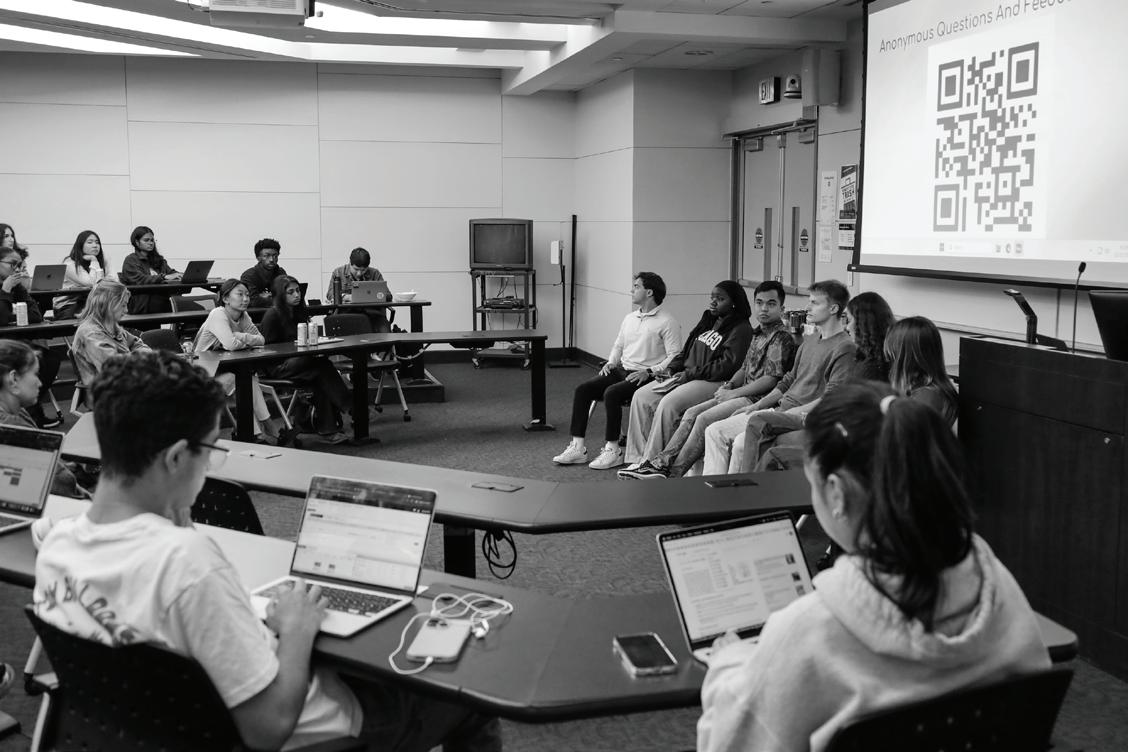
sent troops to patrol the city as part of his crackdown on crime.
Officials said in a weekly federal updates email to community members Thursday they are aware of the increased visibility of the guard on campus. Officials said they are also aware of “limited” instances where guards entered University buildings and confirmed they did not request the guard’s presence on campus.
Officials also clarified that recent reports of guard troops on the Mount Vernon Express shuttle were actually members of GW’s Naval Reserve Officers Training Corps who were erroneously identified as members of the guard because they were dressed in NROTC camouflage uniforms.
SGA President Ethan Lynne said at last week’s Board of Trustees meeting that students are anxious about their physical safety on campus. He held up a photo of guard troops inside Duques Hall — a tap access-restricted building — at the meeting and called on officials to reaffirm their commitment to students’ safety and belonging because students want to feel secure and supported on campus. Stoddard said troops are trespassing any time they enter a building that requires tap access, which Associate Vice President for Campus Safety Katie McDonald confirmed at an SGA Senate meeting last month and encouraged students to send the SGA pictures if they see the guard in University buildings, so they can share that information with officials. She said she has noticed over the past few weeks that the
guard has “creeped” from the Foggy Bottom-GWU Metro station, where they mainly patrolled when they were first deployed, further into GW’s campus and continue to have a larger and more prominent presence.
Stoddard said administrators should make it clear to students that the guard is not allowed on campus and create a reporting mechanism for students to report troops in buildings so GWPD can remove them.
“They have no business on our campus to be quite frank and that admin’s lack of pushback is really disappointing,” Stoddard said.
SGA Sen. Aicha Sy (CCAS-U), chair of the Community, Advocacy and Inclusion Committee, said members of her committee are working to make sure that students feel safe on campus, even with the heightened presence of the guard and federal immigration agents in the District.
“We’ve been having conversations with groups on campus that specialize in talking about undocumented students and their status here at GW and making sure that they have all the resources they need,” Sy said.
Sy said committee will bring a resolution to the full senate soon, calling on the University to support students’ rights to safety, free speech and education and call on the University to reject “federal interference” that threatens these rights. The resolution, which will be presented to the SGA Senate at its Oct. 27 meeting, will urge the University to reject federal monitoring and provide immediate alerts to the GW community regarding federal enforcement.
AINSLEY SULLIVAN | PHOTOGRAPHER
Posse scholar Angel Ntiamoah poses for a portrait in Kogan Plaza.
LOGAN ROTUNNO | PHOTOGRAPHER Student Government Association senators sit on a panel Wednesday.
GRACE MCMAHAN | PHOTOGRAPHER
A U.S. Capitol Police officer leans on his bike outside the Capitol Tuesday.
OPINIONS
There’s
more at stake in GW’s MFA deal than its finances
STAFF EDITORIAL
Officials’ announcement earlier this month that GW reached a preliminary agreement with Universal Health Services to cofund the Medical Faculty Associates marked a critical step toward addressing the University’s mounting financial challenges. After years of stakeholders urging officials to cut monetary ties with the medical enterprise — which sits $444 million in debt and caused GW’s credit rating outlook to drop for the first time in available records — we’re encouraged by the news of ongoing negotiations. But with so much at stake, from the MFA’s central role in GW’s medical education to concerns over UHS’ anti-union labor practices, simply knowing that talks are underway isn’t enough to ease our concerns.
In negotiating with UHS, GW is deepening its relationship with a healthcare management company known for its anti-union stance, history of unfair labor practice charges and a pattern of fostering a negative work environment.
The MFA is also heavily tied to the success of GW’s medical education. SMHS defines the MFA as its clinical pillar, where “as SMHS faculty members, the GW MFA physicians serve as teachers and mentors for medical students, residents, and researchers.” The MFA is not merely a staffing arm but the crucial link between GW’s medical education and its clinical operations, providing the real-world experience needed to produce the “exceptionally prepared health care professionals” SMHS touts. It will be crucial for the community to closely monitor how this deal affects both medical education and the treatment of employees within the enterprise.
We acknowledge that ongoing negotiations and legal constraints may limit how much GW can currently disclose about its partnership with UHS. But as GW engages with

an anti-union company, officials must share as many details as possible and actively seek input from the physicians, students and other stakeholders directly affected by this leadership shift. Above all, we urge GW to remember that while discussions about severing financial ties with the MFA have dominated the conversation, they are not the only priorities the community cares about as all parties weigh the future of the medical enterprise. To be clear, the MFA’s toll on GW’s finances has been severe, and we’re relieved to see officials taking meaningful action to confront it. The medical enterprise, which GW acquired in 2018, has consistently lost millions of dollars over the last six fiscal years — $100 million in
FY2025, $107 million in FY2024, $78 million in FY2023, $78 million in FY2022, $48 million in FY2021 and $43 million in FY2020. These persistent losses prompted GW’s two credit rating agencies to revise their credit rating outlook from stable to negative for the first time in available records — a downgrade that experts warned could prompt the University’s lenders to hike interest rates, add millions of dollars in borrowing costs and reduce long-term investment flexibility. News of the MFA’s FY2025 losses and GW’s downgraded credit rating came as the University grapples with a budget deficit that prompted University-wide cuts, staff layoffs and ongoing reductions to campus operations and services. At a time
The liberal assumption has no place in the classroom
Left-leaning perspectives dominate campus discourse in GW’s social and academic spaces, sidelining conservative perspectives. Professors and students here make an assumption when entering a space: that everyone else is also left leaning. By operating on that assumption, we lose the opportunity to interact with different opinions, which produces monolithic dialogue that ultimately lessens the quality of our education by curtailing the development of bipartisan communication skills.
Just last year, I had a professor who failed to mask his liberal attitude during lectures. Heading into election season, he quipped, “But that’s not surprising for that party,” before quickly moving on. Was it funny? I had thought so, and many of my peers did too. Looking back, though, the professor’s joke was a clear indication of his bias, and it shut down the prospect of a broader conversation about the points made by either party — effectively killing any opportunities for discussion or intellectual growth. What’s worse is how his political bias bled into his course content. Some of the readings he assigned felt strongly partisan in their arguments. For example, one
article described Trump’s supporters as responding only to misinformation, which is occasionally true but not always the case and ignored the other reasons one might support Trump. This bias in the curriculum harms our education by limiting our exposure to differing ideas — an issue that will materialize when students leave this University’s bubble and encounter people with various views and identities.
My peers have reported hearing comments like “What did Trump do this time?” in their classrooms, implying that the problem is widespread. Given this information, it’s necessary that professors put more effort into disguising their personal preferences and fairly presenting all parties or at the very least being respectful of different parties.
That isn’t to say professors are wholly at fault — students also need to check their biases when engaging in any exchange. Liberal voices are too comfortable expressing their opinions as collectively accepted facts, demonstrating that a greater effort on their part is necessary to create open spaces for the sake of their education.
I realized the bias as I was speaking with other Hatchet opinions writers. Since this realization, I noticed that the liberal assumption is held even within classroom discussions, which is especially troubling as a political science
major. Currently, students in class often preface their statements with generalizations like “We all know” the recent Republican budget proposal is “ridiculous.” The assumed agreement is problematic. It discourages other ideas from entering the conversation, which hampers our ability to have productive and genuine debates.
By allowing bias to seep into the classroom, alternative ideas struggle to enter discourse. Without that valuable commentary, we miss an exchange of ideas that could facilitate learning opportunities and promote empathy between peers.
Unless we speak with the intent of inviting diverse ideas, we’ll only exacerbate the effects of echo chambers, and our own education will suffer. Finally, and most importantly, the conservative population at GW needs to be more vocal about their positions, especially in academic settings, to remind others that this University doesn’t represent just one party. It is not their fault liberal voices assume verity, but it is their responsibility to demand the respect their ideas deserve.
If we are ever going to engage in a meaningful conversation about our differing beliefs, we, professors and students alike, need to recognize the assumption and make a conscious effort to negate it.
—Vanessa Paige, a sophomore majoring in political science, is an opinions writer.
Swhen GW is struggling financially and bracing for hits from President Donald Trump’s higher education policies — including cuts to federal loans and grant programs, declining international student enrollment and a crackdown on diversity, equity and inclusion programs — we believe the University is in no position to keep extending financial support to the medical enterprise. For this reason, we were heartened to see GW taking a meaningful step to disentangle itself. But that does not diminish our concern over GW’s growing partnership with a company that has mounting accusations of mistreating the University’s nurses and service workers. GW first partnered with the company in 1997 to run
GW Hospital, and UHS became the sole owner of the hospital when the University sold its minority stake in 2022. GW and UHS also entered an agreement in 2018 with D.C. to open the Cedar Hill hospital, a $434 million facility staffed by MFA physicians and operated by UHS, which D.C. opened in April.
The relationship between UHS and GW Hospital’s nurses and service workers’ unions has been a tangled, ongoing mess. Years of allegations — from discouraging union participation and engaging in bad-faith bargaining to firing and disciplining employees for union activity — have kept tensions high. Even after National Labor Relations Board interventions and a December settlement, the nurses’ union filed five new unfair labor practice charges last spring, showing that disputes continue as bargaining resumes.
GW’s talks with UHS underscore a high-stakes tension as the University faces the urgent need to address the MFA’s persistent financial losses while ensuring the quality of its medical education and maintaining fair treatment for its workforce. The deal may help stabilize GW’s finances, but it also ties the University even more to a company with a documented history of anti-union practices. As the MFA remains central to training the next generation of physicians, the stakes are far higher than just finances . Transparency, acknowledgement and active community engagement are essential as GW moves forward because the consequences of this partnership will be felt by medical students, faculty, physicians and other stakeholders. How GW navigates this deal will define not just its finances but the future of its medical school and the lives of the people who run the medical arm of the University.
GW’s pre-professional student body overlooks the value of office hours
tudents often think professors exist only to deliver lectures, assign readings, grade exams and submit reports to their department chairs. But students often overlook the resources, advice and experience professors can offer to us outside of the classroom. This opportunity is incredibly valuable but frequently forgotten at places like GW, where students often think they can learn the most from internships and extracurriculars.
Luckily, there are office hours. There is a designated time in a professor’s week where they stay in their office, sit behind their desk and wait for a student to appear behind their door and timidly call their name. Professors have been in our exact same place. Therefore, they can understand us and act as mentors and counselors for us to face the difficulties and uncertainties of college life: finding a job, experiencing discussion and dissent and coping with doubts about our future and incomprehension. But students at GW prioritize our pre-professional culture, always more concerned with internships and the advice they can get from whatever politician
they’re interning for, and the expertise of professors gets lost in their list of priorities. Many students may think of office hours as not the most efficient use of their time. But what many fail to understand is how essential it is to get to know the person behind the lecture. In GW, students often assume that they learn enough from their professors alone, but this is not true. Office hours are the greatest invention that the American university system, and GW, has provided to students — professors can recommend you books, help you find a master’s degree, chat about politics or give you life advice. They will recommend internships and advise you on career paths or simply let you know what the workforce looks like for your major. It is an exceptional opportunity and a privilege that the GW student body should take advantage of.
This December, I have to apply for my master’s degree, which I will be starting next year at my french university. With many doubts in my head, making a final decision on which degree to pursue has been one of my greatest burdens these months. How to choose from so many possibilities? I do not have a definitive answer yet, but I sure have some hints. I went to my Latin American politics professor’s office hours. In one hour and a half, I left inspired, more confident in myself and
in what I want to do in the future. He oriented me on my major’s career outcomes, while telling me about his own experiences working in the public sector. Getting to know his journey as an academic, a researcher and a politician helped me decide on what I want to do. These doubts concerning my future drove me to ask my history professor how I could start doing journalism as a postgrad profession. He told me he was a historian and still could write for a political magazine and even become its editor. It is he who encouraged me to continue writing for The Hatchet. Thanks to my Latin American political science instructor, I have a better idea of which master’s degree I want to choose. Going to office hours opens the door to interpersonal knowledge. As W.B. Yeats once said: “Education is not the filling of a pail but the lighting of a fire.” That fire can only be lit if we dare to reach out, if we build relationships with our professors and aim for human connectio. To do that, I have not yet found a more effective tool than GW’s office hours. Dare to try, go to office hours, and if you’re lucky, you’ll find a mentor that you will never forget in your life.
—Santino Bernacchi, an exchange student from Sciences Po Paris majoring in social and political science, is an opinions writer.
Santino Bernacchi Opinions Writer
ABBY TURNER | STAFF CARTOONIST
Vanessa Paige Opinions Writer
SPORTS
For
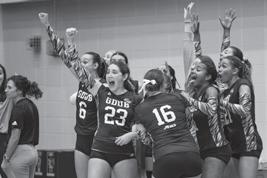
Lipitz, the future of GW sports has echoes of its past
The last few years have been volatile for college sports.
The introduction of studentathlete compensation through name, image and likeness and revenue sharing models and clearance for unlimited transfers has transformed the environment. With GW nearing a decade without men’s or women’s basketball making the NCAA tournament, Director of Athletics Michael Lipitz said he is attempting to navigate the choppy waters by building an “elite” department that elevates its basketball programs — a move he said will boost the entire department and, in turn, the University.
In an interview on Thursday, 14 months into his tenure leading GW Athletics, Lipitz said that he’s focused on using Athletics to “help lead the University forward.” In Foggy Bottom, he says, this starts with sending money into men’s and women’s basketball.
“I’ve been very consistent since I got here last year, that we’re going to lead with basketball,” Lipitz said.
The department also relies on partnerships and ticket sales as ways to bring in money. Lipitz touted Athletics’ recent sponsorship deal with Vanda Pharmaceuticals, which features the Foggy Bottombased company’s logo displayed on the Smith Center court as men’s basketball’s “presenting sponsor.”
But as officials direct money
and attention toward basketball, how much time is needed before the community sees this translate into wins?
Lipitz’s courtside view
Lipitz said he remains realistic about what a winning men’s basketball program will look like at GW. In an era in which the Atlantic 10 is struggling to send more than one team to the NCAA Tournament each year, he said he understands being a perennial championship squad is not a fair expectation to put on the team.
“To position the program to be in the mix year-in and year-out is where you want to be,” Lipitz said. When GW hosted Georgetown University in an exhibition game last Saturday — the Smith Center’s first sellout in a decade — Lipitz was reminded of the glimpses he saw of the heyday of GW’s 1990s basketball, further shaping his vision for the Revolutionaries.
“That’s what we’re working back towards,” Lipitz said.
Lipitz nudges Athletics toward institutional alignment
Lipitz looks to play to GW’s strengths as an elite academic institution in a premier city to build a brand, recruit and support their student-athletes.
Alignment between the University and athletics is a vital aspect for Lipitz and a big reason why he

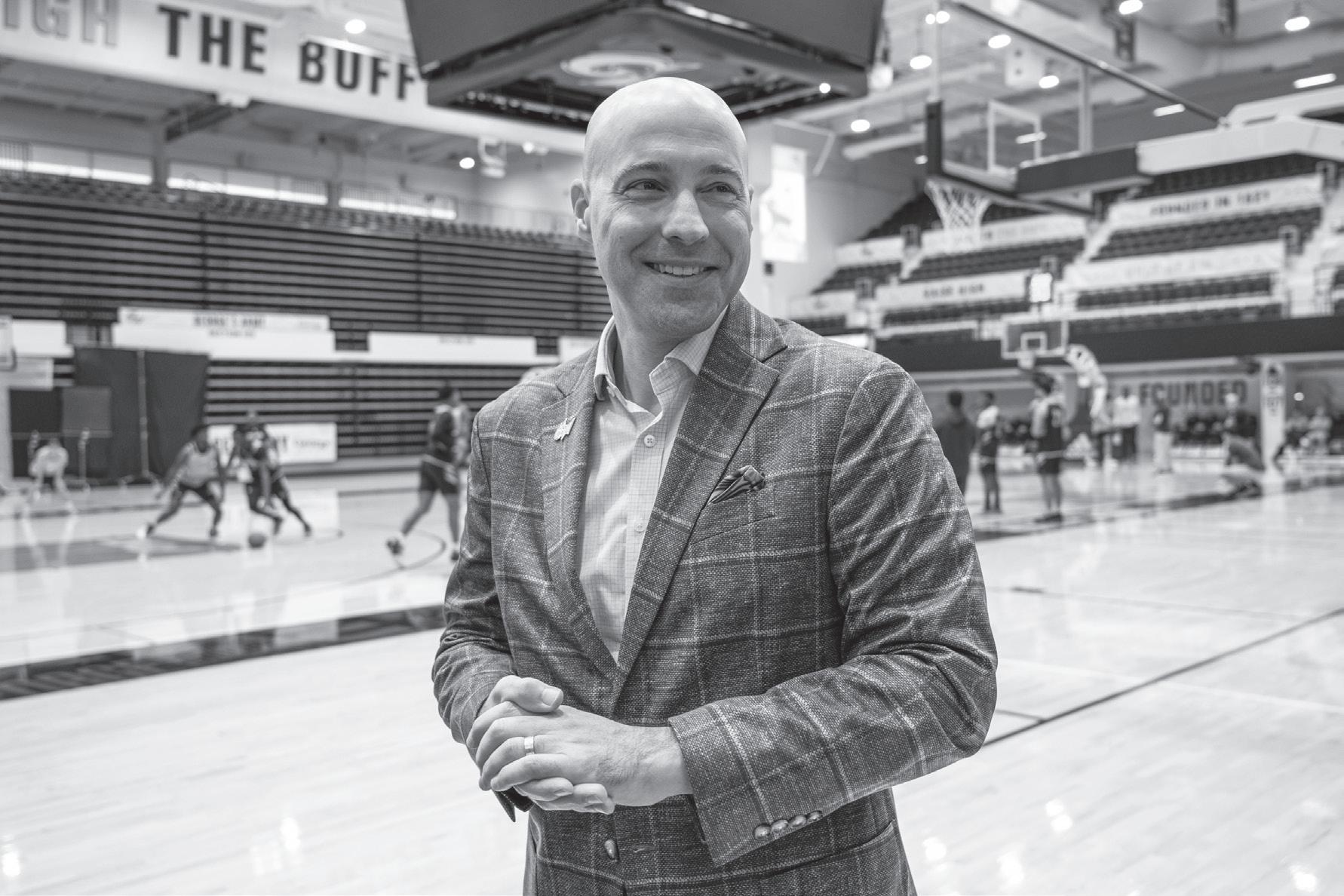
made the leap from the University of Illinois Chicago to GW. He said he felt confident his vision would be supported by institutional powers, including University President Ellen Granberg, who has used her position as GW’s chief executive to emphasize the role athletics play in recruiting stronger students, woo-
ing donors and sharpening the school’s national profile. With men’s basketball looking to return to the NCAA tournament this year for the first time since 2014, Lipitz and the A-10 are in support of an expansion to the field he said could make that easier.
As NCAA officials debate adjust-
ing the now-68-team tournament to 76, Lipitz said a larger field will give A-10 teams who are “right at the top” of the league a better shot at at-large bids.
“Hopefully we get those opportunities, and we’re trying to position ourselves to be one of those teams to grab a bid,” Lipitz said.
Volleyball drops pair of matches at Davidson, extending conference skid
Volleyball (13-10, 6-5 Atlantic 10) fell in both road matches against Davidson (10-11, 5-6 A-10) on Friday and Saturday, extending their losing streak to four after a strong start to conference play. The Revolutionaries managed just one set win in the series, as Davidson swept both matches 3-0 and 3-1. With the pair of losses, GW fell from a top-three position earlier in the season to fifth in the A-10 standings past the midway point of
conference play. Their four-game skid — driven by inconsistent hitting — has shifted the Revs’ focus from competing for a top seed to fighting to remain within the championship field. Throughout the series, the Revs struggled to establish an effective attack, failing to find rhythm or efficiency on offense in either match.
Here’s a recap of the series:
Match 1: Davidson 3, GW 0
The Revs fell behind early in the set Friday, down 3-9 before chipping away and
taking the lead back 16-13. However, Davidson finished off the final set strong, retaking the lead at 17-16 and never letting it go. The Revs got off to a strong start early in the second set, taking off to a 7-3 lead. Davidson bounced right back with 4-straight points to tie the match. After the Wildcats strung together another 5-straight points, Davidson led 16-11 — a lead that was too much for the Revs to overcome as the Wildcats captured the second set 25-17.
Davidson kept the momentum going into the third set, winning 10 of the first 12 points to take a command-
ing 10-2 lead. While the Revs scored 12 blocks on the day, they were unable to defend against Davidson’s attack, giving up 41 kills and losing the final set 25-15.
Match 2: Davidson 3, GW 1
In the second contest Saturday, the Revs hitting struggles continued, especially in the first set, where they had just six kills and a hitting percentage of zero. The Revs conceded 11 of the first 12 points to Davidson, failing to mount a comeback and dropping the first set 2511. The second set proved
Men’s soccer suffers seventh-straight conference loss
MAYA ROSADO REPORTER
MATTHEW CINQUE
REPORTER
Men’s Soccer (2-10-3, 0-7-0 Atlantic-10) fell to Dayton (4-2-7, 2-1-3 A-10) 1-0 Saturday afternoon during their final home game of the season, extending their conference losing streak to seven.
The defeat marked the Revolutionaries’ final home game under Head Coach Craig Jones, who will step down after 14 years leading the program at the end of this season. Men’s soccer honored its four graduating athletes — senior forwards Alex Nicholson, Pat Altamirano and graduate student forwards Babacar Fall and Rashid Seidu-Aroza — in a pre-match ceremony with their families and teammates, before the team was shut out by the Flyers.
GW Athletics announced Jones’ exit earlier this month, after he struggled to perform over the last three seasons of his tenure. He led the team to an A-10 regular season championship in 2015 but hasn’t been able to eclipse a .500 record since the 2020-21 season.
On Saturday, the Revs fell behind when Dayton sophomore forward Andrew Armstrong scored in the 54th minute, receiving the ball off of a rebound from the left post.
The Revs held the Flyers tight through the first half, allowing only three shots on goal but struggling to generate offense of their own, leaving the first half scoreless.
Junior goalkeeper Tom Macauley anchored the Revs’ back line with several key saves, including a low stop in the 45th minute of the first half on a shot from Dayton’s Cooper Lijewski. The Flyers generated several opportunities, earning six corner kicks in the half though they were ultimately unable to capitalize on any of them.
Physical play defined much of the first half, with 11 fouls shared between the two sides and yellow
issued to Poole and Dayton’s
more competitive than the first, with the Revs jumping out to an early 7-4 lead. However, Davidson’s offense soon found its rhythm, overpowering GW as the Wildcats pulled ahead to take the set 25-16 and build a 2-0 lead in the match. The third set was the most competitive of the series. The teams battled back and forth, with neither able to amass a large lead throughout. The Revs were ultimately able to capture the third set 25-22, pulling ahead toward the end off kills from sophomore opposite Taylor Treahy and graduate student middle blocker Sydney Hasenfratz.

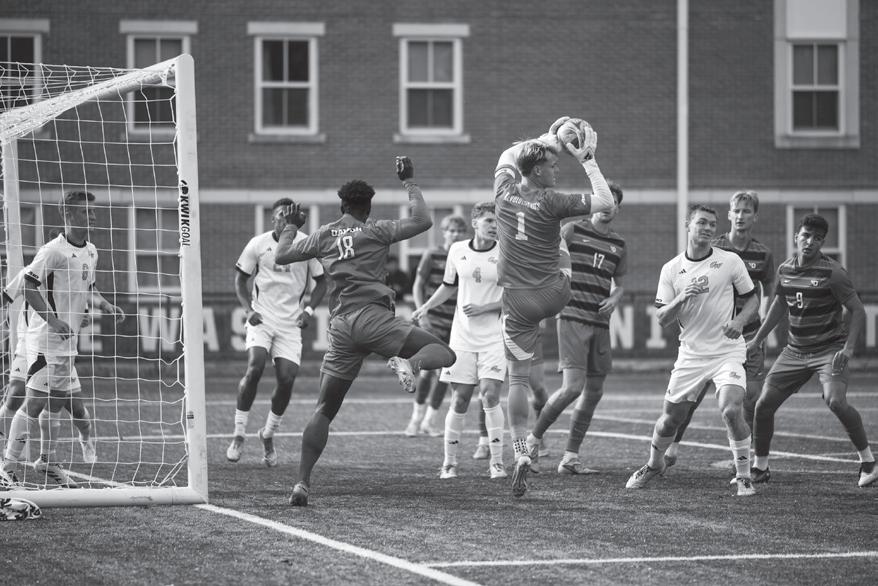
to

The Revs were able to improve their hitting percentage in the third set, climbing to .433 featuring just three errors and 16 kills. Still, the squad failed to continue this efficiency into the final set, as the Wildcats immediately halted whatever momentum the Revs may have carried into the fourth set, jumping out to an early 10-2 lead. Despite the Revs’ efforts to chip away at the deficit, the gap proved insurmountable. GW hit just .000 in the final frame as Davidson closed out the match with a 25-16 win. Next up, the Revs travel to face crosstown rival George Mason on Wednesday at 6 p.m.
wouldn’t recover from.
The Flyers then took control of the game, taking eight shots in the following 15 minutes. In the 60th minute, Macauley got the better of Lijewski again, this time in a oneon-one situation.
Dayton junior midfielder Martin Bakken in the 65th minute carried the ball from the halfway line to the edge of the Revs’ 18-yard box and found Armstrong on the left wing, who tucked the ball into the right corner but found himself in an offside position. The goal was quickly waved off after this call.
With 20 minutes remaining, the Revs switched their backline from five defenders to four to send an extra player forward in attack. In the 74th minute, the Revs had three successive shots in the Flyer’s box, the first of which delivered by senior forward Alex Nicholson, with junior forward Louis Saville striking the following two. Then in the 71st minute came the Revs’ best chance, as freshman forward Joel Russ carried the ball from the halfway line to slip junior forward Jaden Dubon in behind Dayton’s backline. Dubon hit a strike with pace, but it ended up hitting the outside of the right netting.
The Revs continued their pursuit of a tying goal in the final minutes as they utilized long throw-ins into the box, delivered by Poole. Their efforts were not enough, however, sealing the 1-0 defeat in Jones’ final home match as head coach.
The result extends the Revs’ winless streak to 11 and is the ninth of 16 games this season they failed to score in. They conclude their home games with a record of 2-5-2, consistent with the previous seasons’ home records of 2-4-1 in 2024 and 3-4-2 in 2023. The Revs will wrap up their season on the road against La Salle (4-4-7, 2-2-3 A-10), who currently sit seventh in the conference. Seeking their first A-10 win, the Revs were eliminated from tournament qualification due to their lack of conference points.
cards
Miles Bonham. The Revs started the second half quickly, accumulating four shots in the first 10 minutes, including two chances for junior forward Jaden Dubon in the box. They were unable
score on any of the attempts. Despite the Revs’ momentum, Dayton broke through in the 54th minute following an outside shot from Dayton junior midfielder
Braden Seel that hit the left goal post. The ball landed at the feet of Dayton sophomore forward Andrew Armstrong, who buried a low shot past the Revs’ goalkeeper, giving the Flyers a 1-0 lead GW
RACHEL KURLANDSKY | STAFF PHOTOGRAPHER
Junior forward Jaden Dubon chases the ball during Saturday’s game against Dayton.
MATHYLDA DULIAN | ASSISTANT PHOTO EDITOR
Director of Athletics Michael Lipitz poses for a portrait in the Smith Center during a men’s basketball team practice.
RACHEL KURLANDSKY | STAFF PHOTOGRAPHER Junior goalkeeper Tom Macauley catches the ball.
RACHEL KURLANDSKY | STAFF PHOTOGRAPHER
Head Coach Craig Jones watches the game against Dayton.















Halloween Guide












Hatchet staff tell tales of the paranormal on campus
From unexplainable shadows in Kogan Plaza to visits from the ghosts of Foggy Bottom folklore, The Hatchet staff have collected some of their creepiest encounters on campus.
The ghost townhouseof

past Hannah Marr | Managing Editor
Tyler Iglesias Senior | News Editor
It was 4 a.m. on a Monday, and we were putting finishing touches on the week’s edition of The Hatchet. As the issue neared completion, we migrated from the townhouse’s ground floor to its rickety basement.
Then, the townhouse’s upstairs door opened, the blinds hitting the glass pane. We heard footsteps and were perplexed.
That’s when we knew. Janet.
In 1947, Ida Stoll lived at the townhouse at the time and died in the building. But the legend of this ghost takes another name: Janet, though nobody knows how, why or when she came around.
Armed with a fly swatter, we ascended the basement stairs, pausing before reaching the last step, lined one by one behind each other.
We held our breaths and launched onto the first floor, prepared to encounter Janet. Scour-
ing, we realized it was all clear. We then traversed the steps to the second floor, and, again, there was nothing there. Our hearts beat rapidly as we climbed the steps to the third floor to check Janet’s last hiding spot. But it too was clear.
A chill went down our spines: the door never opened again. The footsteps never left.
The menacing specter Mitchellof Hall

Renee Purcait | Staff Writer When moved into Mitchell, I came across several cryptic messages left behind by past occupants of my dorm. I would wake up to the faucet turning on by itself, or to eerie noises coming from the courtyard. Not to forget the creepy sounds of people running in the hallways of the basement that I would hear while doing my laundry, just to find out no one was ever there.
My most terrifying memories are from the times I would be showering and the lights would mysteriously turn off. The first few times it happened, I thought it was a coincidence, or there was some sort of sensor in the bathroom. But both of my assumptions were wrong, and once again, I was left with an experience I could not explain.
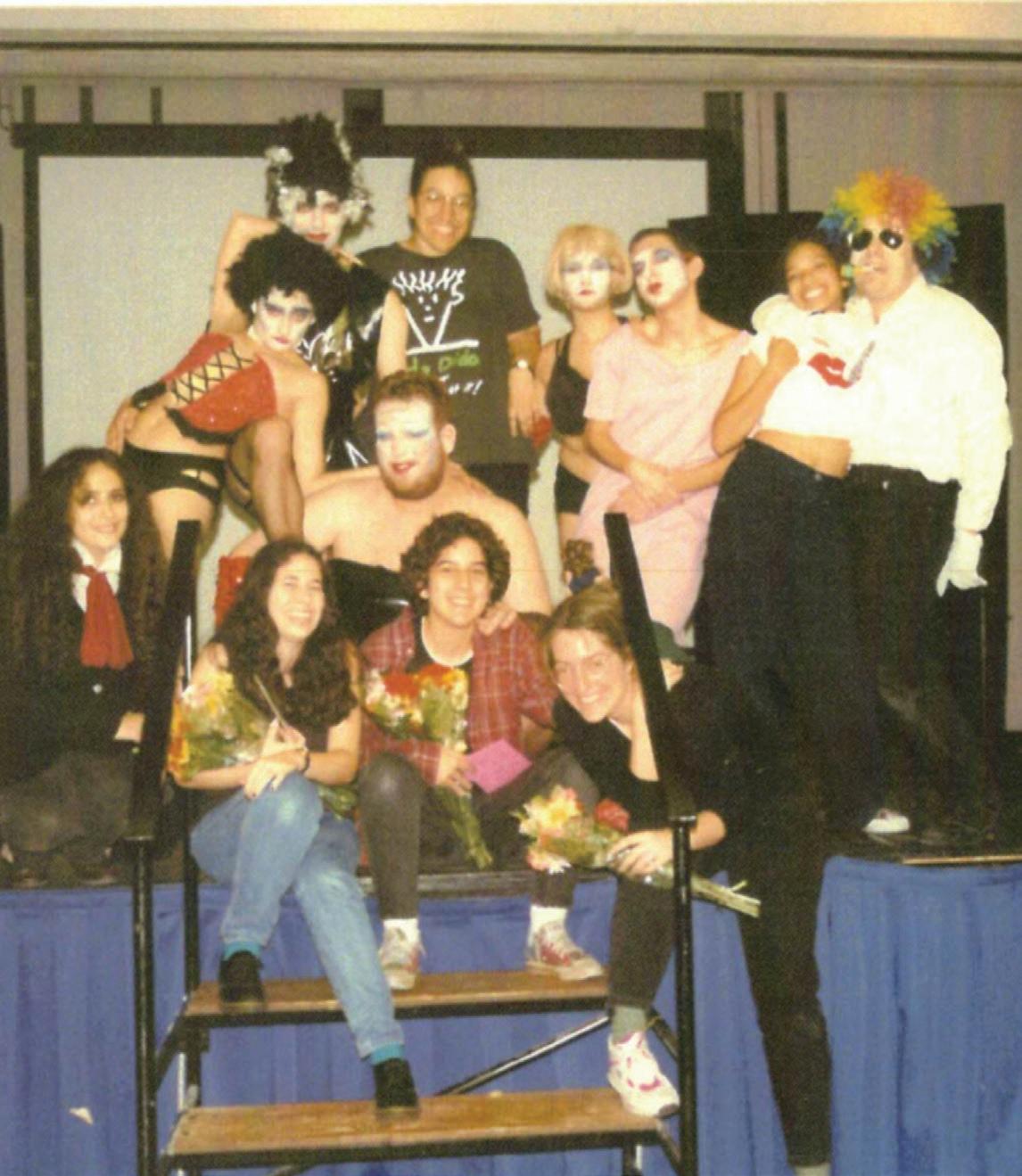





Snow day shenani gans to ghost ly grazes

Alex Kennedy| Reporter At 2 a.m. one snowy evening, my friends and I were on our way back to campus from a snowball fightand wound up in Kogan





when I felt something. A touch across my shoulder blade.
I laughed and turned, assuming my friend was messing with me. But her hands were shoved deep in her coat pockets. I felt it again — I grabbed her arm, and we ran, pushing through Gelman’s revolving doors, hearts hammering. She suggested it was the wind, maybe a branch, but I




knew what I felt.
My friend wondered aloud if maybe I’d been overreacting. I almost believed her, until it happened again. She tensed a second after I did, and I before I knew it we were sprinting across Kogan to seek refuge in District. The building seemed impossibly far, and I felt something tugging at the hood of my coat.






‘Let’s do the time warp again’: 30 years of Rocky Horror at GW
A student theater organization has been filling the stage with leather, lingerie and lace every Halloween weekend since 1996.
GW student theater group Forbidden Planet Productions puts on “The Rocky Horror Picture Show,” a musical inspired by the movie and known for themes of sexual freedom and self-expression. Fifty years after the release of the cult-classic movie and 30 years since the first show at GW, the group continues to welcome audiences to a show filled with onlooker participation
and traditions. Jennifer Rellis, FPP’s founder, who graduated from GW in December 1996, said she and a few other students started FPP 30 years ago just to put on a production of Rocky. She said the group wanted a space to express themselves and be involved in theater without the “trappings” of the theater major.
“I really enjoyed the non-conforming message of the movie, the fun of it, the excitement of kind of an entertainment of shouting lines back at the screen, making up new lines,” Rellis said.
She said having a space for people to be themselves without being judged is needed more than ever today.
First-year Maxwell
Roberson, who plays Frank-N-Furter in this year’s production, said he originally auditioned for Brad Majors but he said the FPP directors envisioned him as Frank.
Roberson said Rocky Horror is a cultural piece of art and a healing experience for many queer people and having the opportunity to play Frank in the anniversary show is an honor for him.
Sophomore Harper Hazlitt said she was asked to direct this year’s production of Rocky Horror after playing Riff Raff her freshman year.
She said during her freshman year show she said she remembered being “shocked” when a fellow cast member told her she would be
“virtually naked” on stage, but FPP made the experience comfortable, reminding members that creative costuming choices are up to them.
Rox Neems, who graduated from GW in 2007, said she joined FPP “pretty much immediately” her freshman year and was in Rocky’s ensemble.
“I’m really impressed by all that, and I’m just glad that it’s still giving people the opportunity to express themselves and to have this kind of unique experience because there’s so much that’s part of the experience that, it’s just really is unique, there’s just things that you can do, say and act that are just like, that just don’t really translate easily to anything else,” Neems said.



As seasonal picks line the shelves of children’s books aisles, young readers reach for the beloved classics of one Corcoran School of the Art & Design alum time and time again.
Ruth Chew, who attended Corcoran in the 1930s, authored the well-known book series, “A Matter-Of-Fact Magic” about children discovering enchanted objects, like wizards and flying vacuums, in their everyday lives. Chew contributed to the canon of children’s Halloween books, finding magic in the mundane.
In 1969, Chew’s first book “The Wednesday Witch,” was published by Scholastic Book Services, inspired by her daughter’s pleading for witch stories. Chew went on to write 28 other books in the series, and Penguin Random House began reprinting two books from the series each year in 2013.

with Scholastic Books after years of professional setbacks due to sexism. Sprunt said Chew would not have become the artist readers know today without the four years she spent training at the Corcoran School of Art, now the Corcoran School of the Arts & Design after GW acquired the institution in 2014.
After graduation, Sprunt said Chew had a brief stint in Baltimore, Maryland drawing newspaper advertisements for brands but that she returned to Corcoran for night school as a source of inspiration and camaraderie in her career. But Sprunt said the main inspiration for “The Wednesday Witch” was from Chew’s youngest daughter always begging her to tell witch stories in the car.
Melissa LaSalle, the children’s books buyer at Old Town Books in Alexandria, said Chew’s books made her enjoy the thrill of the possibility of magic as a child.


Eve Sprunt, Chew’s daughter, said her mother passed away in May 2010, after moving to the California Bay
Area in 2001 from Brooklyn, New York to be closer to her children. Sprunt said her mother’s belief in magic was her greatest strength as an author and illustrator, contributing to her imagination and creativity as she put pen




to paper to illustrate and write her books. Sprunt said Chew’s imagination was childlike, and her mother often thought of herself as an 11-year-old trapped in an adult’s body. “She dreamed up the sort of
things that kids that age want to do,” Sprunt said. She said her mother’s considerable imagination went hand-inhand with a tenacity that allowed her to publish her self-written and illustrated children’s books




While Chew’s books are on the older side compared to the children’s books on the shelves at Old Town Books and other stores today, LaSalle said she appreciates the timelessness of “The Wednesday Witch” and its companions.
“I think her tone and the way that she writes still feels very relevant to me. It’s very funny,” LaSalle said.
GRACE MCMAHAN | PHOTOGRAPHER
Kogan Plaza on a fall evening.
The
Forbidden Planet Productions Rocky Horror Picture Show cast pose for a portrait during a show.

















Halloween Guide
At WitchFest, locals congregate to celebrate all things witchy
Over the past two years, a District-wide coven of sorts has emerged through DC WitchFest, as resident spell-casters have collaborated to celebrate witching culture.
The DC WitchFest organization serves as a hub for the DMV’s witches and witchcurious individuals to curate a community of witchery through parties, markets and festivals. Organizers and vendors said the group allows for likeminded individuals to connect via their witch-centered interests and expand opportunities for celebrating the culture, not just during the Halloween season.
Skye Marinda, coorganizer and tarot card reader, said she started the organization after organizing year-round Witches Night parties at the Dew Drop Inn, which include tarot to celebrate witchcraft. They said co-organizer RJ Lucas curated art markets at the time, and
the two decided to collaborate to create the first WitchFest event with the goal of creating a hub for those interested in witchcraft.
They said the organization has expanded to include events centered around other holidays and events relevant to witchery. Marinda added that the events help create a space for magic-minded people to meet and do “witchy things,” and the number of opportunities for people in this sphere has been growing around the D.C. area. They said being able to foster more opportunities for these creative, niche communities has been a “cool” experience, expanding on opportunities in the D.C. area for witches to convene in a social manner.
Marinda said this month’s event emphasized local witches’ want for social spaces like this, as interest in witchery has expanded in recent years, with attendees noting they wished the event was longer and hoped for larger gatherings
in the future. They said the crowd’s excitement manifested through their intricate costumes and full-throttle displays of creativity through fashion.
“I think it’s cool to see so many people come together and be excited about Halloween, getting witchy, getting to put their creativity on display,” Marinda said. “Someone was dressed up in a banana witch costume that they made themselves, like the banana peel was the witch hat. Just cool stuff like that all day.”
Co-organizer RJ Lucas said she has been a D.C. resident for 15 years and has spent time organizing various happenings across D.C., especially in the art community — but she and Marinda wanted to craft an organization to host events to connect people with witchy interests, providing more opportunities for mystical meetups in D.C.
She said WitchFest allows people in a hyper-political city to gather to do











Between haunted hubs, fall foliage, Victorian architecture and ghoulish storefronts, Old Town Alexandria knows how to curate a Halloween hot spot.
That’s why we spent Monday afternoon venturing to the quaint downtown area to get a stronger taste of the Halloween season than Foggy Bottom provides. With its small-town atmosphere and allegedly haunted past, Old Town seemed like the best nearby locale to spend a few hours in an atmosphere reminiscent of Salem, Massachusetts — with both regions being steeped in history and spookiness.
Our journey started — as most do — at the Foggy BottomGWU Metro, taking the blue line to King St-Old Town in our most autumnal attire of pleated skirts and tan jackets. After the 20-minute ride, we exited the station and walked down King Street, with brown fallen leaves crinkling under our feet.
something that is not overtly governmental, though everything, including witchery, has political undertones. She said she loves going to the events and speaking to people who identify with less mainstream spirituality and seeing them excited to talk about these beliefs with other practitioners.












these beliefs with othShe said the turnout at this event pleasantly surprised her and Merinda, allowing them to picture an expanded version
She said the turnout at this event pleasantly surprised her and Merinda, allowing them to picture an expanded version of WitchFest in the future.



“Skye and I are just blown away with how many people not only were interested leading up to it but actually showed up,” she said. “Our events in the past have been a few hundred people who will come through throughout the day and a more typical community market kind of event. And this year is the first time that our dream of it being a festival — DC WitchFest — is really manifesting.”



dream of it being a festival — DC WitchFest — is really manifesting.”




From cocktails to galas, students’ favorite bars prepare for Halloween



ing Manager Lexi McClure said planning starts early on for the holiday, usually at the beginning of the summer, which proves to be beneficial when there’s a line of eager college students and young adults out the door until 3 a.m.
As Halloween creeps closer, GW students’ favorite bars and hangout spots are trading pumpkin spice for potions, transforming into eerie escapes filled with cobwebs, costumes and cocktails.
The restaurant’s speakeasy transforms what staff dubs a “Spookeasy” through a hidden freezer door, where decorations and lights set the stage for Halloween nights.





Across the District, business owners are turning their spaces into haunted hangouts to draw in college students and young adults eager to celebrate in spooky style. Bar managers say they’re rolling out themed drinks and dishes, decking out their spaces with Halloween decor and bringing on extra security to handle the crowds — all to welcome the wave of revelers who give business a boost this time of year.
Angela Camara, bar manager at Salazar, a taco and tequila bar on 14th Street, said the restaurant has been booking large Halloween parties for months. She said staff plan to swap their uniforms for costumes over Halloween weekend and while the decor stays minimal, the lighting and energy make the space feel perfectly eerie.
Camara said the bar typically plans their Halloween specials up to two months in advance to prepare to coordinate among management, staff, mixologists and the marketing team.
Chicken and Whiskey, a South American restaurant located on both 14th Street and in the Navy Yard, is hosting Cocktails and Screams, which is their “Spookeasy” all month, attempting to lure customers to experience their transformed space. Market-
At Swingers in Dupont Circle, a mini golf venue and bar, General Manager Erik Bolme said the spot — which includes an arcade serving street food and craft cocktails — is kicking off the Halloween season with a weeklong spookythemed celebration extending from last Monday to next Sunday.
Bolme said Swingers will also be participating in the annual “Nightmare on M Street” pub crawl this year, providing access to multiple venues in the Dupont Circle area that students can visit for discounted drinks.
On U Street, Whitlow’s General Manager Brendan Simmons said his love for the holiday influenced staff to start planning festivities — including creative cocktails, live music and a costume contest — in July. He said their “Nightmare on U Street” Halloween event, a nod to the “Nightmare on M Street” Halloween festivities that were popular in Georgetown years ago, will take place on Halloween night from 9 p.m. to closing at 2 a.m.
“I have the entire restaurant decorated now for Halloween,” Simmons said. “We have lights on the outside of the building that turn into Halloween colors. People seem to really enjoy it, and it’s a safe spot for everyone to come in and have a good time.”

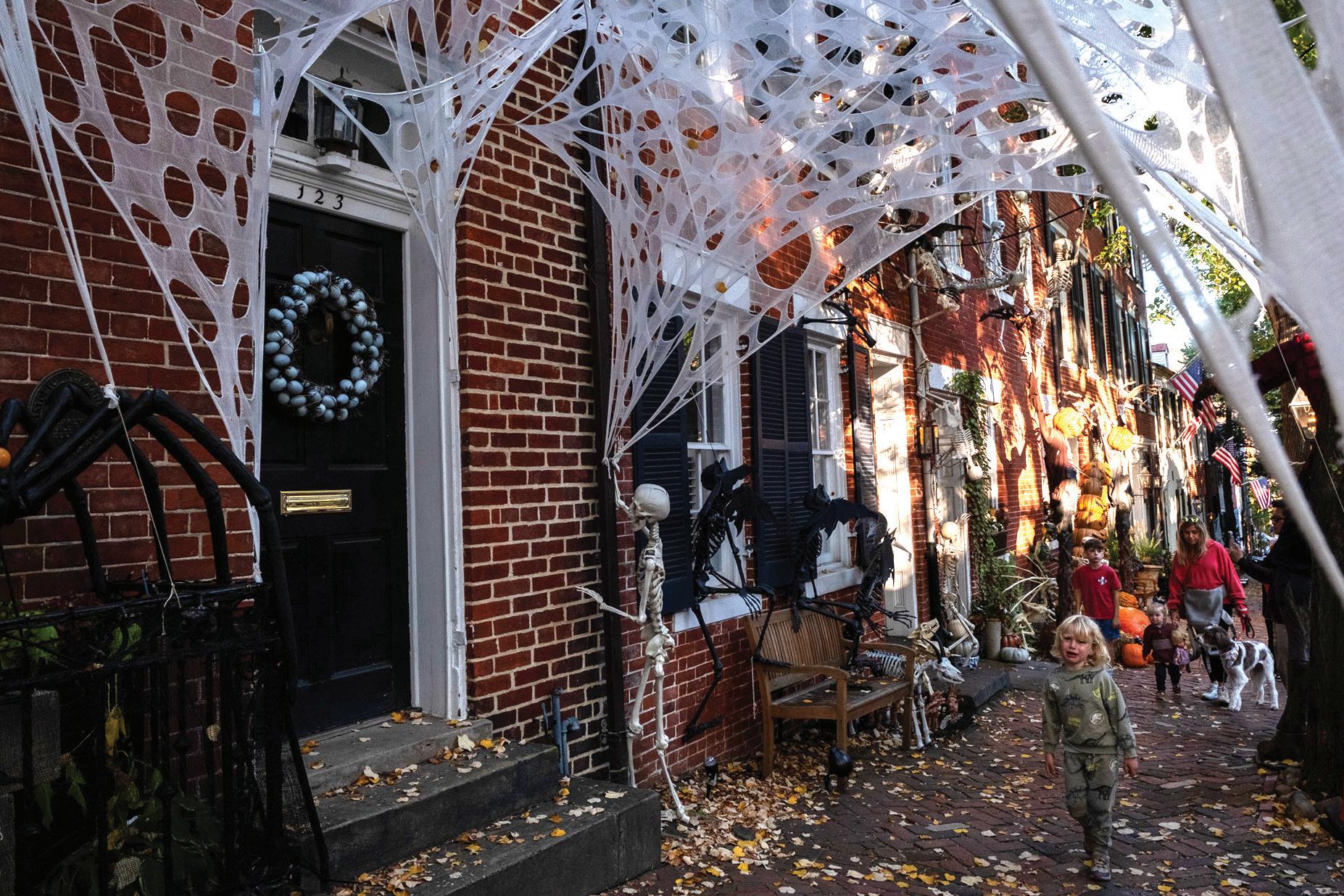
The lines of historical rowhouses and storefronts, many with spider web-clad windows and pumpkin-lined porches, were under the cover of semigreen, semi-yellow trees and dappled with late-afternoon sunlight. The streets were fairly quiet, with red-and-brown trolleys passing by the shop win-




dows displaying “Happy Halloween” banners and witch figurines.
In hunt of some of the more speculated haunted sites, we made our way to Gadsby’s Tav-
Our trip through the haunted streets of Old Town Alexandria


















for several ghost stories online, one of them detailing the tale
ern Museum, a place with alleged ghost tales from over a century ago. The tavern is also the setting for several ghost stories online, one of them detailing the tale





of “The Female Stranger,” a tale about a couple who arrived at the tavern to stay for the night while the wife was very sick. As the legend goes, the husband brought her into room number eight, refused to reveal his name and left an unsettling air of suspicion. The wife soon died from a severe ailment, while he vanished leaving his debts behind, and her spirit is said to continue haunting the tavern. We walked into the first tavern, which opened in 1785 and became a museum in 1976, and were met by a small gift shop with booklets and historicallooking figurines lining the shelves. After paying $5 each for admission, we made our way to the dining rooms, with a few tables set with realistic-looking fake food. Menus recreated from the tavern’s early days in the 1780s were scattered across tables for viewing — a dinner with “beer, cyder or one Gill of good Spirits” cost 50 cents, which equates to $10 today. As we took the blue line home, we were transported back to our day-to-day routines but with the memories of Halloweeny spent in the splendor of Old Town.
back to our day-to-day routines at GW — but with the happy a sunny, afternoon movie-like








ADNAN MASRI | STAFF PHOTOGRAPHER
Whitlows on U Street decorated for Halloween.
GABRIELA ROJAS-LEBRON | PHOTOGRAPHER
Attendees dressed up during DC WitchFest earlier this month.
GRAPHICS BY ABBY TURNER, AMELIA COLEMAN AND ANYA MALHOTRA
